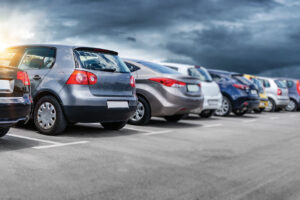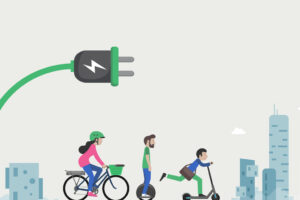By Mathieu Verronneau, ing. & Paul Hanratty, MBA
Condominium Parking Garage Maintenance
Introduction
Your parking garage, if not maintained properly, can be one of the most expensive costs to your Condominium Corporation. Repairs to your garage can cost millions of dollars and create massive disruption over multiple years to the quiet enjoyment of your home and investment.
Background
The National Building Code Standard for Parking Structure construction and protection is CSA S413, “The Canadian Parking Standard”. This building code document provides guidance for designers and builders of parking structures. The current issue of this standard is a highly informative document but falls short in several areas related to protection of structural elements within parking structures. Deterioration of structural elements like columns, slabs, ledge beams etc., accelerates quickly if these elements are not protected. De-icing salts greatly accelerate the deterioration of unprotected structures.
One can find all details on this standard at:https://www.csagroup.org/store/product/S413-14/
Historic Building Process
Condominium structures are built by property developers and in most urban settings the parking garage is generally underground. Developers have a two-year obligation to the Condominium Corporation covering non-structural and non-life safety components of the building. This includes waterproofing structural elements in the parking garage and elsewhere. The short warranty period incentivizes some developers to install the minimum protection required by the building code. The current code only requires that elevated slabs be protected by an elastomeric membrane and traffic bearing surface. It does not require that the Architect or Designer of structural protection systems design for durability. This lack of guidance in the building code will be changed significantly with the new iteration of CSA S413:21, due to be released later in 2021. The new code will require that deck membrane systems be designed to receive four distinct levels of…
By Ryan Hickey
For many cities and municipalities, parking is at the center of their decision-making these days, whether it is from a revenue, usage patterns (current and future) or an operations perspective. As we move towards getting back to a new normal in 2021, the issues that were impacting the parking experience prior to COVID-19 are sure to resurface, perhaps with a slightly different appearance.
All too often, there was, and still is, a negative experience related to urban parking, with the majority of community members believing that parking resources are not meeting their needs. This perception is fueled by the length of time it can take citizens to find an available parking stall and is frequently used as the main metric for gauging whether a region has an efficient and sufficient supply of parking. When finding a possible solution, cities and municipalities must consider a large number of variables while planning out parking zones, including budgets, land use, and the overall community experience. Overall, this process becomes extremely overwhelming and can be exacerbated by inaccurate parking data supplied by outdated or inaccurate methods.
Urban planners face a variety of challenges in collecting reliable and accurate parking data to improve overall parking user experiences. Presently, many decision makers are unable to form concrete plans towards improving their parking, due to a lack of real-time data availability, and ever-changing parking behaviours driven by COVID-19. At a time when most individuals are working from home, it could be questioned whether there is a need for increased parking. In some areas of North America, it was noted that parking levels were at an all-time low, as citizens were encouraged to stay home and reduce unnecessary travel. For example, sensor data collected within Stratford, Ontario demonstrated a significant decrease…
By Adamo Donatucci
Like any industry heavily reliant on technology, the urban mobility marketplace continues to evolve with advances in available and emergent technologies. Today, it is common for owners and operators to use technology to engage their customers virtually while retaining an element of personalized interaction.
During the COVID-19 global pandemic, the healthcare industry has proven to be a fascinating case study in the application of advanced parking technology to support the vertical’s broader goals of increasing staff and patient safety while simultaneously reducing hospitals’ and clinics’ capital and operating costs.
Virtualization of the customer experience was driven initially by market preferences for technology-forward service solutions that generated value for parking operators by reducing overall expenses without sacrificing the high level of service that draws traffic to their facility. While this remains an important consideration today, the COVID-19 global pandemic has accelerated efforts to provide the services people need at a distance that keeps them safe.
Early efforts to virtualize the customer experience centered around providing lower-cost alternatives to on-site staffing by directing intercom calls from an attendant’s desk to an off-site monitoring station to save on staffing costs. Today’s technology gives parking operators the flexibility to deploy AI-driven kiosks that assist users to navigate large and complex facilities; in some deployments, this includes turn-by-turn directions back to their car based on the license plate number they enter.
With a greater-than-ever demand for touchless access solutions, parking operators are developing new systems that let users interact with the equipment without ever coming into contact with it; some suppliers have even found ways of integrating gestures to activate ticket dispensing and are leveraging Bluetooth Low Energy technology for permitted access. And just arriving on the market are technology integrations that begin the virtual customer experience before drivers…
By Adam Wenneman
The curbside is one of the most poorly understood parts of the municipal right-of-way. On the one hand, it’s a huge piece of municipal infrastructure that is essential to the urban transportation landscape, supporting billion-dollar industries like goods movement and ride sharing. On the other, it is a scarce – and diminishing – resource whose management principles remain rooted in 20th century technologies.
In a time where curbside uses are growing to include expanded patios, dedicated courier loading zones, and other temporary uses, cities need to leverage innovations in collecting, managing, and sharing curb data to improve the efficiency of operations at the curbside.
The Curbside is a Critical Municipal Asset
The curbside is a major piece of infrastructure for every municipality. Across Canada, on-street parking represents upwards of 20% of a city’s total parking supply1. In some cities, like Saskatoon or St John’s, on-street parking constitutes almost all of the downtown parking supply. In downtown Hamilton alone, there is room for over 1,100 parking spaces at the curbside – that’s an area equivalent to the size of ten NHL-sized ice rinks. Efficient operation of this space is an important factor in a city’s ability to support the future of urban mobility.
Despite its considerable supply, the curbside remains a limited and scarce resource at a time where demand for curb space is at an all-time high. The curbside is a limited resource in that its supply cannot grow substantially in urban areas with well-defined built environments and road networks. At the same time, cities are beginning to repurpose the curbside and even entire roadways for alternative uses like active transportation, outdoor dining, and shared community space2. Make no mistake – increasing the amount of green, livable space in a city can have major…
By Alicia Smart, Passport
Over the past decade, the City of Hamilton has experienced a tremendous influx in urban growth and development. The City, known for its tourism and medical research, is also the fastest growing mid-sized city in Canada for tech and healthcare. This rapid growth and urbanization have caused the City to reimagine its parking operations.
Many areas in Hamilton are undergoing secondary plans to ensure that there are land use, transportation, and infrastructure plans in place to meet the needs of the growing communities. Hamilton’s parking operation handles all on-street parking related matters, inclusive to parking bylaws. In addition to the day-to-day parking that occurs on Hamilton’s 2,700 on-street and 5,000 off-street paid parking spaces, construction, special events and filming heavily utilize parking. Many of the core parking surface lots have made way for urban growth and Hamilton expects this to be a growing trend over the next 10 years.
Up until 2019, a large portion of the City’s parking operation was simply collecting and reconciling cash and coin. Enforcement operations caused a number of issues at the time, including hardware malfunctions and coin jams. Additionally, data collection was almost non-existent due to the coin and cash dependence. “When I joined the parking system in 2017, what I saw was a large group of very hardworking people who were working too hard at the expense of manual processes,” says Amanda McIlveen, City of Hamilton parking operations and initiatives manager. “From past experience, I knew that Hamilton was in need of a massive digital transformation.”
Amanda and her team quickly realized that in a data-heavy industry, it is difficult to run a parking operation efficiently using antiquated and manual processes. Leveraging data allows cities to manage and allocate staff properly, manage parking demand, create efficiency in…
By Baptiste Corno
Dynamic pricing is clearly the solution nowadays to boost your parking facilities revenue, enhance customer experiences, increase the attractiveness of a city center, lead urban flow and provide drivers with discounted parking spaces. Drivers, parking managers or city managers, this article is made for you.
Our world and our society, are in constant evolution. We will witness considerable changes in the next decade. Some major events have already changed our world this year and we are likely to see more. This decade is the start of a new cycle. We must individually and collectively reconsider our habits and consumptions modes to sustain our future.
Mobility must be one of the top priorities to reconsider. It must evolve toward more autonomy, shared transportation, environmentally friendly and connected usage. Car Parks must also evolve in the same direction and all of us must adopt a very positive approach if we want to succeed.
The development of dynamic pricing solutions in parking facilities is one of the first areas to change because it will help everybody in the community, especially consumers and their budgets. By helping a wider range of the population, Dynamic Pricing can be used as a public policy that benefits a large number of people while providing optimization for private entities. Dynamic Pricing can be the solution of numerous challenges. Xavier Zakoian, CEO & Founder of Kowee, leader in Dynamic Pricing solution for the parking industry stated that: “The objective to achieve is not necessarily revenue optimization. It can be, but it can be customer satisfaction, customer targeting, occupancy maximization and so on”. Dynamic Pricing techniques are an answer to the actual issue regarding urban traffic flow in Smart Cities.
Infotraffic presented an example of Dynamic Pricing strategy at the Virtual Canadian Parking Association Conference…
By Joni Eros
We take choice for granted in our daily lives. We choose what we’ll eat or drink; what we listen to on the radio or watch on tv; what products we use each day; and who to befriend in our lives. There’s a cliché about life being about choices, but it’s true. We make so many every day that we begin to take them for granted.
Historically, choice has not been a significant element of parking. Sure, drivers get to choose where to park, but that is pretty much where their freedom of choice ends. Once they choose a parkade or on-street space, the parker has to use the meter the city has installed, or the PARCS or pay-on-foot equipment the garage offers.
Why does choice matter when it comes to parking payment? Simply put, we don’t all like the same things. Some people are Coke, some are Pepsi; some are Apple, and some are Windows; some like Tim Hortons and some—ok, everyone likes Tim Hortons.
The chasm is particularly wide when it comes to technology. The most obvious 21st Century example can be found in smartphones. Some of us are iPhone users and some are Android. Different people experience technology differently, and that affects their preferences. While one phone may seem alien in its layout and functionality, the other seems entirely intuitive.
The good news is that the evolution of the parking landscape is drastically changing, providing drivers more choice than ever. This is particularly true when it comes to mobile payment. As mobile payment becomes increasingly popular, municipalities, institutions of higher education, and private parking operators are adopting the multi-vendor model on a global scale. And this increased choice benefits both drivers and parking organizations.
Choice Benefits Everyone
In today’s technology-dominated parking world,…
By Kevin Uhlenhaker
More than six months into the Covid-19 pandemic, the parking industry is still reeling. Canada has done better than its neighbor to the South, but the measures that were required slow the spread of the virus (at least relatively speaking) have also had a major impact on parking and transportation. The combination of government-enforced lockdowns and corporate work-from-home policies decimated parking demand, and while people have begun to venture out again and the economy is showing signs of rebounding, public experts tell us to prepare for a very difficult winter.
In fact, the impact of the pandemic will be felt for years to come. Parking revenues at least in many locations will likely be down for the foreseeable future—at least into next spring and, perhaps summer—as public health will be a primary consideration in how owners and operators manage their parkades.
New Approaches to Staffing
One of the most obvious impacts of the Covid-19 crisis on parking operations will be found in staffing. As parking lots and parkades begin to fill up again, parking owners and operators will need to find ways to minimize interactions between staff and parkers. Many experts believe that the Coronavirus is still going to present an on-going risk even after there is a widely distributed vaccine. Without draconian governmental intervention a non-insignificant portion of the population will opt to not get the vaccine and for others, it may not be 100% effective or long lasting.
Parking owners and operators can help to protect their customers and employees by limiting face-to-face interactions. That begins with moving staff out of areas of the facility where they are likely to come into direct contact with parking customers. The most obvious place to start is at exit booths. When staff are taking payment…
By Blake Laufer
Author’s Note: I was fortunate to present at the recent CPA Virtual Conference on the topic of AI, data, and video analytics in parking. As a result of that presentation I was asked to expand on the topic for an article.
According to professor Pedro Domingo at the University of Washington: “People worry that computers will get too smart and take over the world… but the real problem is that computers are too stupid and they’ve already taken over the world.”
Parking managers recognize the need to have data for decision-making. When meeting with colleagues or bosses every decision needs to be supported by charts and graphs and data to garner support. The good old days management by intuition and experience are gone.
Computing systems, and especially those we find in parking operations, are wonderful at collecting massive quantities of raw data. But raw data isn’t useful to the typical parking manager; the data needs to be converted into information before it is useful.
Raw data is a raw material like iron ore, while processed data is like finished metal, something that can be used for productive ends.
Artificial intelligence comes in a variety of forms including natural language processing (“OK Google…”), making recommendations such as what to purchase on Amazon or what to watch on Netflix, and even predictive analytics (hurricane forecasting).
In parking there is one type of AI that we encounter the most, machine learning.
Machine learning is an application of pattern matching. That is, if you show the computer enough patterns then it becomes able to detect and predict that pattern in new data that it has never seen. A simple pattern may only need 10 or 20 inputs before the machine starts to recognize it. A complex pattern…
Brendan McEwen – Director, Electric Mobility & Low Carbon Strategies, AES Engineering Ltd.
Over the next two decades, Canadian cities will experience a profound transition from transportation systems dominated by personal vehicles with combustion engines to electric mobility systems. “Electric mobility” encompasses personal electric vehicles (EVs), electric transit, e-bikes, car-sharing, ride-hailing, ride-sharing, and perhaps one day, autonomous robo-taxis. Parking professionals have a crucial role to play in speeding the transition to electric mobility, realizing the benefits that it can provide to their communities and to parking authorities’ bottom line.
The transition to electric mobility will provide financial, safety and quality of life benefits for all members of our community. Depending on where you are in Canada, EVs typically cost 65% to 80% less to fuel than comparable internal combustion vehicles. Likewise, Consumer Reports recently published data confirming that EVs have half the maintenance cost of conventional vehicles. All told, Canada’s 2 Degrees Institute estimates that the average Canadian EV driver will save $27,000 in fuel and maintenance costs over a 10-year operating life.
EVs still currently have higher initial costs than conventional vehicles, due to the cost of batteries. However, battery costs are declining rapidly – industry average lithium-ion battery costs have reduced from approximately $1200/kWh of battery capacity in 2010, to $156/kWh in 2019. Average battery costs are projected to decline to $100/kWh by about 2024, at which point there will be no price premium for EVs. Indeed, Elon Musk recently described how Tesla can achieve costs of approximately $65/kWh in the next three years. Given the improvements in battery technology and manufacturing, sources as diverse as the Canadian Vehicle Manufacturers Association, International Council on Clean Transportation, and Bloomberg New Energy Finance agree that battery cost reductions…













